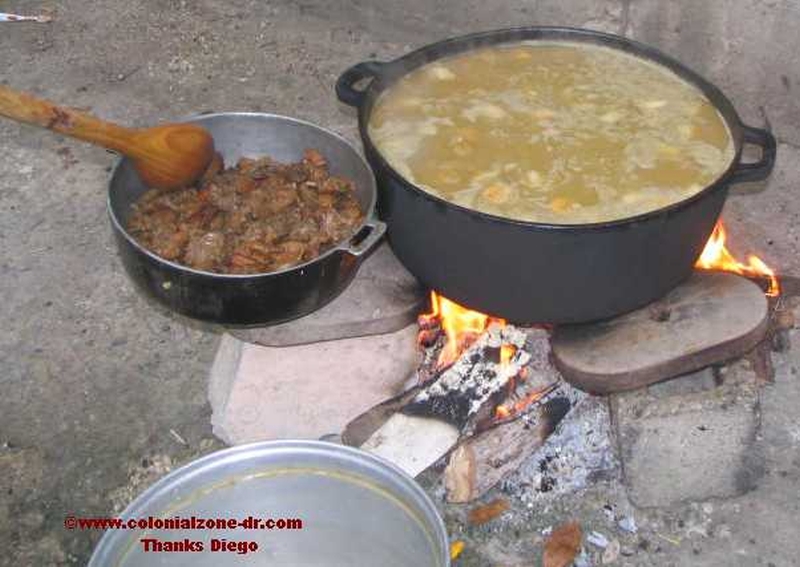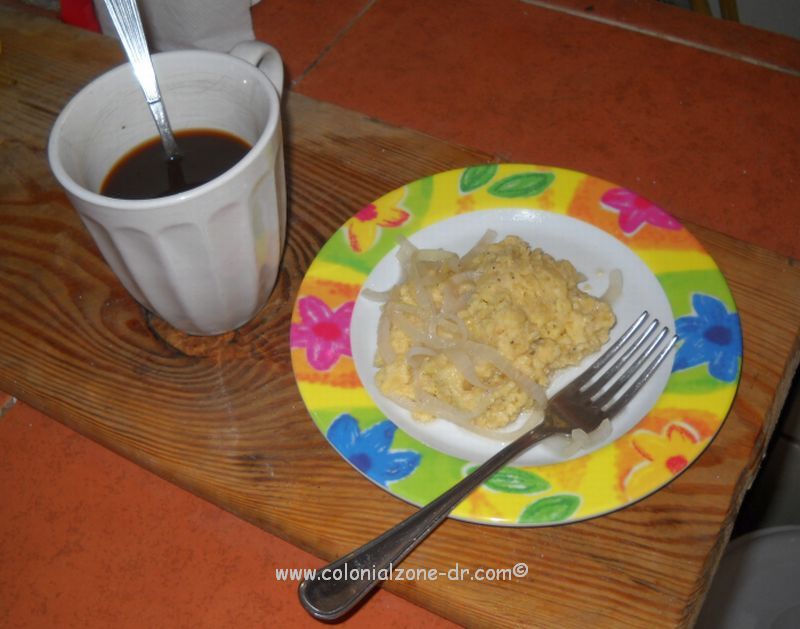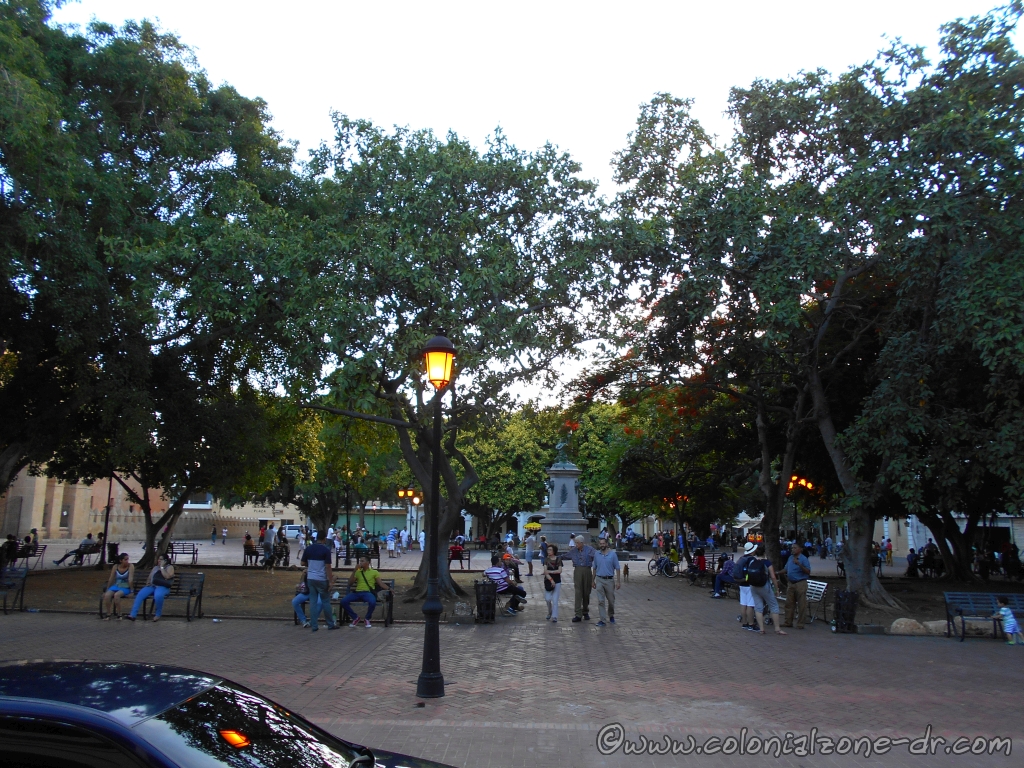Dominican Recipes Page 1 – Sanchocho & Platanos
When I first came to Dominican Republic I had no idea what a Platano – Plantain was or how to use it. I thought it was a fat banana at first sight. This got many laughs as I tried to peal it to eat it like a banana. I have learned and also now I do enjoy cooking with this gree banana looking vegetable. And of course, there is Sanchocho, the food that Dominicans are most proud of. It is the favorite of all.
These are a compilation of things I have learned in my limited cooking experiences here in The Dominican Republic. Some recipes I have changed a little to make them my own. Other recipes are traditional Dominican and cannot be changed. If you try any of these recipes and you like or have an idea for a change let me know. If you have a special recipe you would like me to add please send them my way with a picture or 2.
Sancocho | What is Platano and what does one with it? | Monfongo | Mangú | Tostones | Platano Maduro | Platano Frito As Bread
Sancocho

Sancocho is Dominican Republic’s favorite. The countries signature dish is also known as the official dish of the country. This hearty stew type dish is traditionally made with 7 different types of meat. It can also be made with whatever meat and vegetables you have on hand. There are as many versions of this recipe as there are stars in the sky (maybe not that many, but very close).
It is normally made on special occasions. Many people like to cook it for Christmas. It does take some time to prepare but it is well worth the effort. Enjoy this hearty stew with some rice and avocado and you’ll think you are in Dominican Republic yourself!
3 lbs. chicken
2 lbs. pork chops or ham bones included
2 lbs. beef with bones
1 lb. goat meat
2 lbs. assorted sausages
4 large unripe platanos cut into large pieces
1 lb. potatoes
2 lbs. yucca of cassava cut in pieces
2 lbs. malanga cut in pieces
2 lbs. Spanish pumpkin
5 ears of corn on the cob cut in chunks
1 lb. yams cut into pieces
6 liters of water
4 TBSP oil
1 1/2 TBSP oregano
5 tsp. salt
2 sour oranges if not available use 4 lemons
2 TBSP celery
2 green bell pepper cut in large pieces
3 medium size onions
1 TBSP garlic (smashed)
oregano
thyme
cilantro or parsley
2 cubes of chicken or beef bouillon
2 tsp. vinegar
2 TBSP Worcestershire sauce (English Sauce) or soy sauce
Instructions
1. Cut the chicken in different pieces, wash the meat (except the sausages) and rub with sour orange or lemons. Cut into small pieces.
2. Brown the beef in the oil with herbs, onions, garlic, pepper, Worcestershire sauce (Salsa Americana), and salt for 20 minutes. Add pork and simmer 15 minutes. Add little water as necessary so it doesn’t stick Add the chicken with the stock and simmer another 10 minutes.
3. Bring the water to a boil and add the veggies and simmer for about 10 minutes
4. Add the meat and simmer until the veggies are soft. Mash some of these veggies and return to the pot to thicken the broth.
5. MY FAVORITE STEP. Put in a bowl. Serve with rice and avocado on the side. Add some hot sauce to taste. Lift the spoon to your mouth, close your eyes and savor the flavor of the country.
Platano – Plantain

What is a platano (plantain) and what do you do with it?
Platanos/ Plantains are in the Banana family. What is thought to be a tree is really an herb, the worlds largest herb for that matter. It has a compacted, water-filled leaf stalk that is composed of leaf sheaths that overlap each other and grow from an underground stem called a rhizome, unlike a trees woody stalk.
This plant can grow as high as 20 feet (6 meters) in height, which is about as tall as a two story house. There are over 500 different types of bananas including green, red and yellow versions.

The platano looks like very large bananas and are usually not eaten raw, they need to be cooked. They are very high in potassium and virtually fat free. These fruits are very versatile as they can be boiled, baked, or fried. Served as a vegetable, starch, or made into a sweet dessert. They can be used unripe or very ripe. An unripe platano is green, hard, and very starchy. The riper they get the more yellow and sweeter they become as the starch turns to sugar. They turn from solid green to a yellow orangish color with dark spots to black, when they become very soft and mushy. They can be used no matter how ripe or unripe they are. When they are green they closely resemble potatoes and are not sweet. As they become riper they become sweeter and the texture changes. The very black platanos are usually used in deserts because they are so sweet. If you fry a green platano it makes crunchy pieces while frying a sweet one the pieces are soft.
Mofongo

Mofongo is another dish made from Platanos. The platanos are fried then mashed chunky with different types of meat and seasonings added. It is then served with a broth you can to moisten the typical dish. It is served in a Pilón. As soon as I get a decent recipe for this typical dish I’ll put it here.
Mangú

Mangú is a very typical Dominican breakfast favorite. It can be served for other meals but it is typically for breakfast. Mangú closely resembles mash potatoes in appearance and texture but the flavor is very different. It is made from the green platano (plantain), the hard banana looking vegetable that is seen everywhere in the country. There are as many different ways to prepare mangú as there are preparers.
I usually figure about 1/2 to 3/4’s of a large platano as a serving for the average human.
For Mangú it is best to cut the platano into about 3 pieces lengthwise (I also divide each piece in half lengthwise). Put the pieces in a pot covered with water (add a little salt if you would like) and boil those pieces to death. They have to be nice and soft. It usually takes 20 minutes or longer. Add water as needed to keep them submerged. Just make sure they are soft. Much easier to mash when they’re soft and this way you won’t get lumps.
Now those platanos are soft and ready for the next step. It is time to decide what you want to add for the mashing process (while mashing sauté up some onions, red if you have them, to put on top of or inside the mash).

Pulverizing them! Some use the water the platanos were boiled in to mash them. Some add a bouillon cube, stock, bacon grease, small pieces of cooked meat (bacon or ham) to flavor the mash. Some use milk as in making mash potatoes. Try all the ways, variety is always good. Add the liquid slowly so as not to get them too runny. I like to add a little green oil (olive oil) or a little butter also. Use a potato masher, blender, hand mixer or food processor. I was taught to use the bottom of a beer bottle. This is what my friends and I use. Anyhow, just start mashing them up til they are nice and smooth. Add the onions or some cheese while mashing if you’d like. Keep mashing until it is nice and smooth. Taste testing all the while to get the flavors correct.
To serve: Fry up some eggs (scrambled are typical), and some fried salami, ham or maybe some fried cheese, slop that wonderful Mangú on the plate. Top it with some of those sautéed onions. Then savor the flavor of a typical Dominican breakfast….yummmm…..
Tostones/ Fried Platano Chips

Peel green plantain and cut in in slices about 1/2 inch thick, usually cut on an angle, I don’t know why and it’s not really that important but this is the “Dominican way”.
Heat up some oil (like making french fries) and drop the slices into the oil. Fry them until they are just a little soft. They are cooked soft but not crispy. Remove from the oil and put on paper to drain some of the oil. As soon as you can touch them, smash ’em! Use anything handy, I use a beer bottle again. The bottom of a plate, anything flat will do. If you are lucky enough to have a Tostonera (this is 2 round pieces of wood, hinged, with a knob-like handle in the center pictures here) whose sole purpose is to smash tostones.
Press each piece to flatten it out, it will get a little scalloped edge sometimes. I like mine very thin but normally they are flattened to about half of the original thickness. Then put the flat platano back into the oil and cook until it has a nice light brown color, just a thin outside crust. Remove from the oil. Drain. Salt if desired.
These can be served plain, with ketchup/ketchu is very typical. I like mine with some vinegar or, typical Unitedstatesian, with Ranch Dressing. Any way you like them they are great. Serve them as you would any potato or french fries. Enjoy!
Note: You can slice these as thin as possible and fry them up like potato chips. They are a nice tasty snack.
Platano Maduro/ Fried Sweet Plantains
Platano Maduro are made with the black skinned or really yellow ripe platanos, as sweet and ripe as they get. They are peeled and cut down the length of the platano into long, flat strips. Between 1/2 to 1 inch thick, depending on your mood.
Fry these pieces in a little green (olive) oil, lard, or any other type of oil or butter. Do not cover the platano in oil, just enough so the oil is halfway up the side of the platano. Fry, turning until they are golden brown and caramelized. Drain. These can be served as you would any potato side dish. The flavor and texture are much different than the tostones.
Platano Frito As Bread

Here is an idea that is really easy and so tasty and a very different way to make a sandwich.
Cook up the Platano Frito the first cooking as normal. Then take a few or the pieces and mash them together to make a big bread sized piece of platano. Fry it up and fill it with sandwich makings.
I like to use it to make a hamburger with all the fixings.













